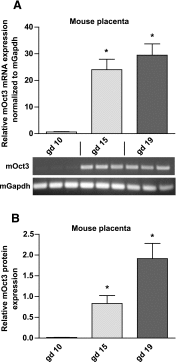Effect of gestational age on mRNA and protein expression of polyspecific organic cation transporters during pregnancy
- PMID: 24101703
- PMCID: PMC3834131
- DOI: 10.1124/dmd.113.054072
Effect of gestational age on mRNA and protein expression of polyspecific organic cation transporters during pregnancy
Abstract
Polyspecific organic cation (OC) transporters play important roles in the disposition of clinically used drugs, including drugs used during pregnancy. Pregnancy is known to alter the expression of drug-metabolizing enzymes and transporters, but its specific effect on OC transporters has not been well defined. Using quantitative polymerase chain reaction and liquid chromatography coupled with tandem mass spectrometry targeted proteomics, we determined the effect of pregnancy and gestational age on mRNA and protein expression of major OC transporters in the kidney, liver, and placenta in mice with timed pregnancies. Human organic cation transporter 3 (hOCT3) expression was further investigated in human placentas from the first and second trimesters and at term. Our results showed that pregnancy had a marginal effect on renal mouse organic cation transporter 1/2 (mOct1/2) expression but significantly reduced mouse multidrug and toxin extrusion transporter 1 (mMate1) expression by 20%-40%. Hepatic expression of mOct1 and mMate1 was minimally affected by pregnancy. Human and mouse placentas predominantly expressed OCT3 with little expression of OCT1/2, MATE1/2, and plasma membrane monoamine transporter (PMAT). The hOCT3 protein in first and second trimester and term placentas was quantified to be 0.23 ± 0.033, 0.38 ± 0.072, and 0.36 ± 0.099 fmol/μg membrane protein, respectively. In contrast with the moderate increase in hOCT3 protein during human pregnancy, mOct3 expression in the mouse placenta was highly dependent on gestational age. Compared with gestational day (gd) 10, placental mOct3 mRNA increased by 37-fold and 46-fold at gd 15 and 19, leading to a 56-fold and 128-fold increase in mOct3 protein, respectively. Our study provides new insights into the effect of pregnancy on the expression of polyspecific OC transporters and supports an important role of OCT3 in OC transport at the placental barrier.
Figures




Similar articles
-
Organic cation transporter 3 (OCT3/SLC22A3) and multidrug and toxin extrusion 1 (MATE1/SLC47A1) transporter in the placenta and fetal tissues: expression profile and fetus protective role at different stages of gestation.Biol Reprod. 2013 Mar 7;88(3):55. doi: 10.1095/biolreprod.112.105064. Print 2013 Mar. Biol Reprod. 2013. PMID: 23303678
-
Gestational Age-Dependent Abundance of Human Placental Transporters as Determined by Quantitative Targeted Proteomics.Drug Metab Dispos. 2020 Sep;48(9):735-741. doi: 10.1124/dmd.120.000067. Epub 2020 Jun 26. Drug Metab Dispos. 2020. PMID: 32591415 Free PMC article.
-
The organic cation transporter 3 (OCT3) as molecular target of psychotropic drugs: transport characteristics and acute regulation of cloned murine OCT3.Pflugers Arch. 2014 Mar;466(3):517-27. doi: 10.1007/s00424-013-1335-8. Epub 2013 Aug 28. Pflugers Arch. 2014. PMID: 23982114
-
Polyspecific organic cation transporters and their impact on drug intracellular levels and pharmacodynamics.Pharmacol Res. 2016 Sep;111:237-246. doi: 10.1016/j.phrs.2016.06.002. Epub 2016 Jun 16. Pharmacol Res. 2016. PMID: 27317943 Free PMC article. Review.
-
Polyspecific organic cation transporters and their biomedical relevance in kidney.Curr Opin Nephrol Hypertens. 2013 Sep;22(5):533-8. doi: 10.1097/MNH.0b013e328363ffaf. Curr Opin Nephrol Hypertens. 2013. PMID: 23852330 Review.
Cited by
-
Impact of pregnancy related hormones on drug metabolizing enzyme and transport protein concentrations in human hepatocytes.Front Pharmacol. 2022 Sep 21;13:1004010. doi: 10.3389/fphar.2022.1004010. eCollection 2022. Front Pharmacol. 2022. PMID: 36210832 Free PMC article.
-
Rifampin Regulation of Drug Transporters Gene Expression and the Association of MicroRNAs in Human Hepatocytes.Front Pharmacol. 2016 Apr 26;7:111. doi: 10.3389/fphar.2016.00111. eCollection 2016. Front Pharmacol. 2016. PMID: 27199754 Free PMC article.
-
Physiologically Based Pharmacokinetic Models to Predict Maternal Pharmacokinetics and Fetal Exposure to Emtricitabine and Acyclovir.J Clin Pharmacol. 2020 Feb;60(2):240-255. doi: 10.1002/jcph.1515. Epub 2019 Sep 6. J Clin Pharmacol. 2020. PMID: 31489678 Free PMC article.
-
A narrative review of metformin in pregnancy: Navigating benefit and uncertainty.Diabetes Obes Metab. 2025 Jun;27 Suppl 3(Suppl 3):16-30. doi: 10.1111/dom.16361. Epub 2025 Apr 2. Diabetes Obes Metab. 2025. PMID: 40171857 Free PMC article. Review.
-
Short-term neonatal outcomes in women with gestational diabetes treated using metformin versus insulin: a systematic review and meta-analysis of randomized controlled trials.Acta Diabetol. 2023 May;60(5):595-608. doi: 10.1007/s00592-022-02016-5. Epub 2023 Jan 3. Acta Diabetol. 2023. PMID: 36593391 Free PMC article.
References
-
- Ahmadimoghaddam D, Hofman J, Zemankova L, Nachtigal P, Dolezelova E, Cerveny L, Ceckova M, Micuda S, Staud F. (2012) Synchronized activity of organic cation transporter 3 (Oct3/Slc22a3) and multidrug and toxin extrusion 1 (Mate1/Slc47a1) transporter in transplacental passage of MPP+ in rat. Toxicol Sci 128:471–481 - PubMed
-
- Engel K, Wang J. (2005) Interaction of organic cations with a newly identified plasma membrane monoamine transporter. Mol Pharmacol 68:1397–1407 - PubMed
-
- Engel K, Zhou M, Wang J. (2004) Identification and characterization of a novel monoamine transporter in the human brain. J Biol Chem 279:50042–50049 - PubMed
Publication types
MeSH terms
Substances
Grants and funding
LinkOut - more resources
Full Text Sources
Other Literature Sources

